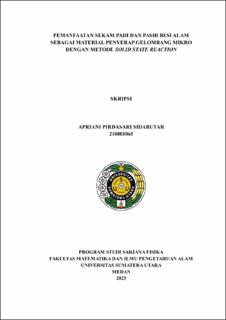Pemanfaatan Sekam Padi dan Pasir Besi Alam Sebagai Material Penyerap Dengan Metode Solid State Reaction
Optimization Of Rice Husk and Natural Iron Sand As Microwave Absorbing Material By Solid State Reaction Method

Date
2025Author
Sidabutar, Apriani Pirdasari
Advisor(s)
Rianna, Martha
Metadata
Show full item recordAbstract
The synthesis and characterization of rice husk and natural iron sand as microwave
absorbing materials have been successfully carried out. This research was conducted
using the Solid State Reaction Method, where the synthesis of natural iron sand from
the river of Jangga Toruan Village, Lumbanjulu District Jangga Toruan Village
produced the phase α − Fe2O3
(hematite). The ratio of natural iron sand and rice husk
were 1:1; 1:2 and 2:1 and synthesized using the Solid State Reaction method with a
calcination temperature of 900°C for 1 hour. The samples were characterized using
XRF, XRD, SEM-EDX and VNA. The most dominant constituent element of natural
iron sand is Fe at 49.52%wt. Based on the diffraction pattern, rice husk and iron sand
as the main raw materials with the main phase a − Fe203
(hematite) and SiO2
(silica). SEM-EDX results show that when the composition of the two materials is
balanced (1:1), the smallest particle size is obtained. The 1:1 sample has an average
particle size of 0.212 μm, 1:2 of 0.275 μm, and 2:1 of 0.293 μm. According to the EDX
analysis it can be concluded that the greater the concentration of Si in the sample, the
number of Fe elements will decrease.. All samples are qualified to be microwave
absorbing materials as evidenced by the absorption percentage of all samples
reaching more than 80%. However, the addition of rice husk to the a − Fe203
/SiO2
material can reduce the RL in the sample. The most optimum composition Reflection
loss of -17.7 dB was achieved with a sample ratio of 1:1 at a frequency of 11.06 GHz
with a microwave absorption percentage of 95.9%.
Collections
- Undergraduate Theses [1380]
